It’s no smooth road to becoming a Michigan conservation officer
Week 20: Nov. 26-Dec. 2, 2017
As if on cue, a collective “Whoa!” rang out from recruits lining the sandy trail as the front end of the off-road vehicle driven by their classmate bounced into the air. Logs and branches deliberately had been placed in the ORV’s way, 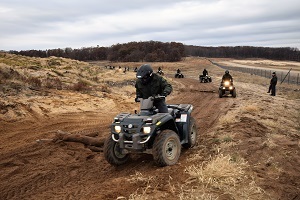 testing the rider’s ability to safely and effectively overcome such obstacles. testing the rider’s ability to safely and effectively overcome such obstacles.
The rider timed his actions well, easing up on the throttle during his approach, then hitting it harder in unison with his spring-like body movement so the four-wheeler’s chunky tires vaulted over the barrier. The helmet and goggles couldn’t hide the expression on his face – part spirited grin, part sigh of relief. Having conquered one challenge, he headed farther down the bumpy trail to meet the next.
Hey, nobody said the road to becoming a Michigan conservation officer is a smooth one.
Acres of open land, revving engines and dirt spitting from underneath tires made for one of the most enthusiastic weeks of training during the Michigan Department of Natural Resources Conservation Officer Recruit School. Recruits embraced the opportunity to log outdoor practice time on ORVs. While they had some fun, the training was as serious as ever.
ORVs are one of the tools that set conservation officers apart from their traditional law enforcement colleagues. 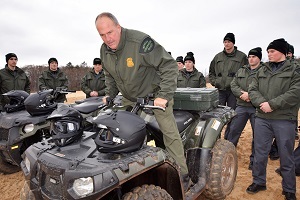 Conservation officers are expected to go where others can’t, and their ORVs are necessary for accessing remote, rugged areas during routine patrols or rescue missions. Four-wheelers, side-by-sides and dirt bikes are part of the DNR Law Enforcement Division’s vehicle fleet. Once recruits complete field training and report to their districts, they may be issued off-road vehicles appropriate for their areas. Conservation officers are expected to go where others can’t, and their ORVs are necessary for accessing remote, rugged areas during routine patrols or rescue missions. Four-wheelers, side-by-sides and dirt bikes are part of the DNR Law Enforcement Division’s vehicle fleet. Once recruits complete field training and report to their districts, they may be issued off-road vehicles appropriate for their areas.
But properly handling these machines takes training, experience and skill. They’re not toys, and as is the case with any motorized vehicle, they must be used responsibly. Navigating treacherous terrain poses challenges even for expert ORV riders, and a moment’s carelessness can cause a machine to roll over or get stuck.
Recruits soaked up their instructors’ words and demonstrated clearly that they grasped the importance of this training. These are skills they will rely on countless times throughout their careers as conservation officers. Still, the eagerness among recruits was apparent as they enjoyed the undeniable “cool” factor of their ORVs.
Revving up
The class spent Week 20 of Recruit School at the Camp Grayling Joint Maneuver Training Center. After spending two  previous weeks there, Camp Grayling has become a second home away from the academy. previous weeks there, Camp Grayling has become a second home away from the academy.
Monday morning’s classroom work introduced recruits to ORV laws and policies. Leading the instruction were Cpl. John Morey, Conservation Officer Chuck McPherson and Conservation Officer Matthew Liestenfeltz.
Instructors then led recruits outside where they learned about ORV maintenance. All conservation officers must maintain their issued equipment. It’s important to keep the vehicles in a constant state of readiness because most law enforcement agencies do not have ORVs. If a search and rescue operation is mobilized, chances are that conservation officers will be the only law enforcement authorities with the equipment necessary to access remote areas.
After learning basic maintenance, recruits got more hands-on with their ORVs by practicing stationary riding positions. They then rode to the ORV training course, where they worked on various riding positions and vehicle maneuverability. After a full afternoon of riding, the class practiced ORV extractions.
Winged watcher
If recruits needed a sign that the week would be special, they didn’t have to look far. In what surely was a good omen, a snowy owl perched itself near the ORV training course Monday, watching curiously for hours as instructors put recruits through their paces. Snowy owls move into Michigan when their food sources on the Arctic tundra are in short supply. In Michigan, they have been seen as far south as Lansing. Because they rarely see humans in their Arctic habitats, snowy owls are not timid and can be viewed easily for long periods of time. The owl’s splendor prompted Sgt. Jason Wicklund, Recruit School commander, to grab a quick photo of it through his spotting scope. Sgt. Jason Wicklund, Recruit School commander, to grab a quick photo of it through his spotting scope.
Rough riders
Recruits were back on their ORVs Tuesday morning. After a brief refresher course on riding positions, the next step was learning to operate the vehicles over obstacles. Conservation officers have wide ranges of land to patrol and don’t always have the luxury of remaining on ORV trails. Their skills must be advanced to the point where they can navigate natural challenges like downed trees, bluffs and mud.
After lunch, trainees went back to the classroom where Conservation Officer Liestenfeltz led a discussion on conducting safe, tactical ORV stops. Stopping an ORV can be difficult for many reasons. ORV operators may not hear a siren over the engine noise or their vision could be compromised by helmets and goggles. The location of a traffic stop can be problematic as well. Conservation officers must pick a spot that is wide enough to let operators maintain control of their vehicles, while ensuring that other ORV 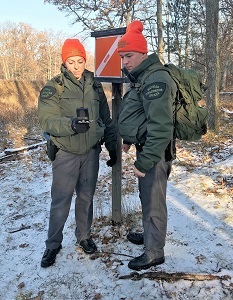 traffic coming along the trail is not obstructed. traffic coming along the trail is not obstructed.
Troubleshooting
Another round of ORV maintenance training greeted the class Wednesday morning. If conservation officers are on patrol and their ORVs break down, they must have sufficient training to troubleshoot the problem, if possible. It’s especially important because conservation officers often work by themselves, without the benefit of nearby assistance. Recruits practiced changing oil and air filters and checking tire pressure, and even washed the ORVs. They then learned the right ways to load and unload ORVs into patrol trucks.
Get lost
Thursday was a change of pace for recruits as they transitioned to orienteering instruction from Cpl. Brad Dohm. Today’s technology makes it easy to rely on GPS from smartphones or other hand-held devices. However, these tools may not be reliable in the field. Batteries can die and signals may not always be available in every corner of the state. That’s why conservation officers must be able to use compasses for orienteering.
Recruits were divided into teams and given sets of coordinates that were used to determine a heading once they reached each waypoint. After three hours of using coordinates, recruits found their way back to the starting point.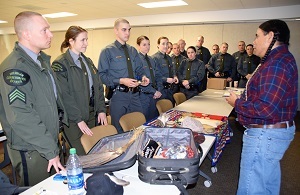
Cultures and customs
Michigan has 12 federally recognized Native American tribes, and conservation officers coordinate closely with their tribal law enforcement counterparts during all seasons since jurisdiction areas overlap. Friday, recruits learned directly from tribal officials about tribal fish and game laws, and how they are enforced. The class also learned about the tribal criminal justice system and what penalties are associated with tribal laws. Presentations were given by representatives of the Little River Band of Ottawa Indians, the Bay Mills Chippewa Indian Community and the Little Traverse Bay Bands of Odawa Indians.
The visit by tribal officials also gave recruits the opportunity to gain an understanding of the cultures and customs of 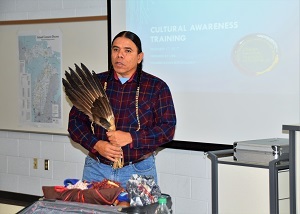 various Native American tribes. This will benefit recruits greatly when they get into the field after graduation and interact with diverse populations. various Native American tribes. This will benefit recruits greatly when they get into the field after graduation and interact with diverse populations.
Action-packed week
Week 20 was filled with busy days that let the class spend lots of time outdoors, taking advantage of Camp Grayling’s sprawling acreage. But as they left the camp Friday, recruits looked forward to entering the home stretch, with Dec. 21 graduation as the prize. If they ever return to Camp Grayling, it will be not as recruits, but as full-fledged Michigan conservation officers.
Subscribe to the weekly conservation officer academy blog, which also will be posted on the Michigan DNR Facebook page. View previous blogs from Recruit School #8.
/Note to editors: Accompanying photos are available below for download. Caption information follows.
Snowy_owl: A snowy owl that traveled to Michigan from its Arctic home watched conservation officer recruits train on their off-road vehicles at the Camp Grayling Joint Maneuver Training Center. Impressed by the owl’s splendor, Sgt. Jason Wicklund, Recruit School commander, snapped this photo through his spotting scope.
Tactical_dismount: Conservation officer recruits practice making tactical dismounts from their off-road vehicles. Recruits must master different skills sets with their ORVs because the vehicles differ greatly from the patrol trucks typically driven by conservation officers.
Sharing_information: Sgt. Jason Wicklund, Recruit School commander, and Conservation Officer Shannon Kritz join recruits in asking questions of Tony Davis, a representative of the Little Traverse Bay Bands of Odawa Indians. Davis helped the class gain an understanding of his tribe’s culture and customs, which is important as conservation officers frequently interact with tribal members.
Riding_the_trail: Department of Natural Resources conservation officer recruits learn to navigate obstacles on their off-road vehicles during a recent exercise at the Camp Grayling Joint Maneuver Training Center. ORVs are an integral part of the DNR Law Enforcement Division’s vehicle fleet because they enable conservation officers to access rugged, remote areas during patrols or rescue missions.
Taking_a_reading: Land-navigation skills are an important part of recruit training. In spite of the GPS technology available today, it might not always work in remote areas, and conservation officers must be proficient at orienteering skills such as map and compass reading.
ORV_loading: In addition to riding off-road vehicles, conservation officers must know how to maintain them and load them into patrol trucks. These skills are especially important as conservation officers usually work by themselves and can’t count on having assistance nearby.
Cultural_awareness: Tony Davis, a representative of the Little Traverse Bay Bands of Odawa Indians, displays eagle feathers and other items of cultural significance during his presentation to DNR conservation officer recruits. The cultural awareness training will benefit the future conservation officers as they likely will interact with tribal members and authorities during their careers. The training raised awareness of tribal laws and customs, and will help the future officers interact with the tribes respectfully and professionally.
Demonstration: Conservation Officer Matthew Liestenfeltz demonstrates proper off-road vehicle handling procedures as recruits observe. Recruits received extensive training in ORV use and maintenance during Week 20 training./
The Michigan Department of Natural Resources is committed to the conservation, protection, management, use and enjoyment of the state’s natural and cultural resources for current and future generations. For more information, go to www.michigan.gov/dnr.
|

 testing the rider’s ability to safely and effectively overcome such obstacles.
testing the rider’s ability to safely and effectively overcome such obstacles. Conservation officers are expected to go where others can’t, and their ORVs are necessary for accessing remote, rugged areas during routine patrols or rescue missions. Four-wheelers, side-by-sides and dirt bikes are part of the DNR Law Enforcement Division’s vehicle fleet. Once recruits complete field training and report to their districts, they may be issued off-road vehicles appropriate for their areas.
Conservation officers are expected to go where others can’t, and their ORVs are necessary for accessing remote, rugged areas during routine patrols or rescue missions. Four-wheelers, side-by-sides and dirt bikes are part of the DNR Law Enforcement Division’s vehicle fleet. Once recruits complete field training and report to their districts, they may be issued off-road vehicles appropriate for their areas. previous weeks there, Camp Grayling has become a second home away from the academy.
previous weeks there, Camp Grayling has become a second home away from the academy. Sgt. Jason Wicklund, Recruit School commander, to grab a quick photo of it through his spotting scope.
Sgt. Jason Wicklund, Recruit School commander, to grab a quick photo of it through his spotting scope. traffic coming along the trail is not obstructed.
traffic coming along the trail is not obstructed.
 various Native American tribes. This will benefit recruits greatly when they get into the field after graduation and interact with diverse populations.
various Native American tribes. This will benefit recruits greatly when they get into the field after graduation and interact with diverse populations.




